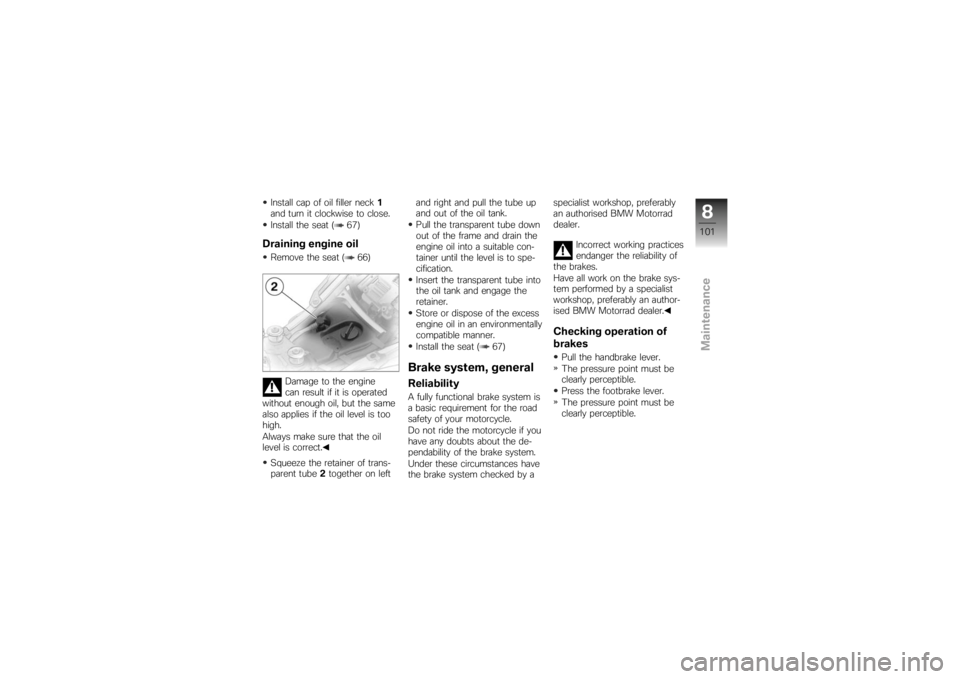Page 88 of 168

If the front wheel lifts clear of the
ground under severe accelera-
tion, the ASC reduces engine
torque until the front wheel re-
gains contact with the ground.
Under these circumstances,
BMW Motorrad recommends
rolling the throttle slightly closed
so as to restore stability with the
least possible delay.
When riding on a slippery sur-
face, never snap the throttle
twistgrip fully closed without
pulling the clutch at the same
time. Engine braking torque can
cause the rear wheel to lock, with
a corresponding loss of stability.
The BWM Motorrad ASC is un-
able to control a situation of this
nature.
Tyre pressure
monitoring RDC
OE
FunctionA sensor integrated into each
tyre measures the air temperat-
ure and the air pressure inside
the tyre and transmits this in-
formation to the control unit.
Each sensor has a centrifugal-
force tripswitch that does not
enable transmission of the meas-
ured values until the motorcycle
has accelerated to about 30 km/
h. The display shows
--
for
each tyre until the tyre-pressure
signal is received for the first
time. The sensors continue to
transmit the measured-value sig-
nals for approximately 15 minutes
after the motorcycle comes to a
stop.
The control unit can adminis-
trate four sensors, so two dif-
ferent sets of wheels with RDC
sensors can be alternated on the motorcycle. An error mes-
sage is issued if wheels without
sensors are fitted to a motorcycle
equipped with an RDC control
unit.
Temperature
compensationThe tyre-pressure readings
shown by the multifunction
display are temperature-
compensated; the reference tyre
temperature for these readings
is always 20 °C. The air lines
available to the public in petrol
stations and motorway service
areas almost invariably show
temperature-dependent tyre
pressures, so in most instances
these gauge readings will not
tally with the readings shown by
the multifunction display.
686zEngineering details
Page 94 of 168
Payload of tankbag
max 5 kg
Note the maximum permissible
payload of the luggage carrier.
Payload of luggage carri-
er
max 5 kg
Case
OA
Release leversEach case has two levers, one on
each side of the lock.
The grey lever marked OPEN is
for opening and closing the case.
The black lever marked
RELEASE is for removing and
attaching the case.
Opening casesTurn the lock barrel in the
OPEN direction.
Pull the grey release lever
(OPEN) up.
Lock straps 1open. Pull the grey release lever
(OPEN) up again.
Pull case lid
2out of the retain-
er.
Closing casesPress catches 1of the case lid
into retainers 2.
The catches engage with an
audible click.
Press catches 3on the lock
straps into retainers 2.
The catches engage with an
audible click.
Check that the catches are
locked securely into place.
792zAccessories
Page 95 of 168
Adjusting case volumeClose the case lid.
Turn the lock strap
buckles1of the lock straps
out.
Pull the lock straps up and out.
This expands the case to max-
imum volume. Close the lock straps.
Press the lock straps against
the case body.
The case volume adapts to the
contents.
Removing casesTurn the lock barrel in the RE-
LEASE direction.
Pull the black release lever
(RELEASE) up.
793zAccessories
Page 96 of 168
Pull the case out of the top
holder.
Lift the case out of the bottom
holder.
Installing caseTurn the lock barrel in the RE-
LEASE direction.
Hook the case into bottom
holder2. Pull the black release lever
(RELEASE) up.
Press the case into top hold-
er
3.
Push the black release lever
(RELEASE) down.
The case is locked into place.
Lock the case.
Check that it is correctly en-
gaged.
Secure attachmentIf a case wobbles or is difficult
to fit, it has to be adapted to
the gap between the upper and
lower mounting. The bottom
bracket on the case can be
794zAccessories
Page 102 of 168
Switch off the ignition.
Check the oil level in oil-level
indicator1. Engine oil, specified level
Between MIN and MAX
marks
If the oil level is below the MIN
mark: Top up the engine oil ( 100)
If the oil level is above the MAX
mark: Drain the engine oil ( 101)
Topping up engine oilRemove the seat ( 66) Damage to the engine
can result if it is operated
without enough oil, but the same
also applies if the oil level is too
high.
Always make sure that the oil
level is correct.
Wipe the area around the filler
neck clean.
Remove cap of oil filler neck 1
by turning it counter-clockwise.
Top up the engine oil to the
specified level.
Check the engine oil level
( 99)
8100zMaintenance
Page 103 of 168

Install cap of oil filler neck1
and turn it clockwise to close.
Install the seat ( 67)Draining engine oilRemove the seat ( 66)
Damage to the engine
can result if it is operated
without enough oil, but the same
also applies if the oil level is too
high.
Always make sure that the oil
level is correct.
Squeeze the retainer of trans-
parent tube 2together on left and right and pull the tube up
and out of the oil tank.
Pull the transparent tube down
out of the frame and drain the
engine oil into a suitable con-
tainer until the level is to spe-
cification.
Insert the transparent tube into
the oil tank and engage the
retainer.
Store or dispose of the excess
engine oil in an environmentally
compatible manner.
Install the seat ( 67)
Brake system, generalReliabilityA fully functional brake system is
a basic requirement for the road
safety of your motorcycle.
Do not ride the motorcycle if you
have any doubts about the de-
pendability of the brake system.
Under these circumstances have
the brake system checked by a specialist workshop, preferably
an authorised BMW Motorrad
dealer.
Incorrect working practices
endanger the reliability of
the brakes.
Have all work on the brake sys-
tem performed by a specialist
workshop, preferably an author-
ised BMW Motorrad dealer.
Checking operation of
brakesPull the handbrake lever.
The pressure point must be
clearly perceptible.
Press the footbrake lever.
The pressure point must be
clearly perceptible.
8101zMaintenance
Page 105 of 168

Checking rear brake pad
thickness
Brake pads worn past
the minimum permissible
brake-pad thickness can cause
a reduction in braking efficiency
and under certain circumstances
they can cause damage to the
brake system.
In order to ensure the dependab-
ility of the brake system, do not
permit the brake pads to wear
past the minimum permissible
brake-pad thickness.
Make sure the ground is level
and firm and place the motor-
cycle on its stand. Visually inspect the brake pads
from the right to ascertain their
thickness.
Brake-pad wear limit, rear
min 1 mm (Friction pad only,
without backing plate)
Make sure that the brake
disc is not visible through
the bore in the inboard brake
block.
If the brake disc is visible: Have the brake pads replaced
by a specialist workshop, preferably an authorised BMW
Motorrad dealer.
Brake fluidChecking brake-fluid
level, front brakes
A low fluid level in the
brake reservoir can allow air
to penetrate the brake system.
This significantly reduces braking
efficiency.
Check the brake-fluid level at
regular intervals.
Make sure the ground is level
and firm and hold the motor-
cycle upright.
with OA Centre stand:
Make sure the ground is level
and firm and place the motor-
cycle on its centre stand.
Move the handlebars to the
straight-ahead position.
8103zMaintenance
Page 119 of 168
Installing rear-wheel
standUse screws1to set the rear-
wheel stand to the desired
height.
Remove retaining disc 2.To
do so, press release button 3. Push the rear wheel stand from
the left into the rear axle.
Install the retaining disc from
the right; to do so, press the
unlock button.
Place your left hand on the
left grab handle of the motor-
cycle
4, and your right hand
on the lever of the rear wheel
stand 5. Lift the motorcycle upright,
simultaneously pressing the
lever down until the stand sup-
ports the motorcycle in the up-
right position.
8117zMaintenance